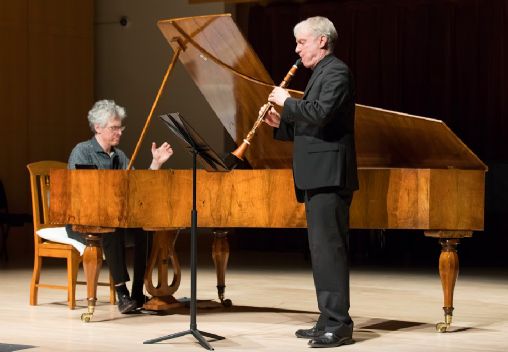|
Symphony
MYSTICAL PLANETS AND LIVELY GERSHWIN ORTIZ AT FINAL SRS CONCERT
by Peter Lert
Sunday, May 4, 2025
Symphony
VSO'S CONCERT MUSIC OF TIME, MUSIC OF PLACE
by Peter Lert
Sunday, April 27, 2025
Choral and Vocal
VOCAL ELEGANCE AND FIRE AT THE 222'S RECITAL APRIL 26
by Pamela Hicks Gailey
Saturday, April 26, 2025
CANTIAMO SONOMA SINGS AN INSPIRED GOOD FRIDAY MOZART REQUIEM CONCERT
by Pamela Hicks Gailey
Friday, April 18, 2025
DRAMATIC SHOSTAKOVICH SYMPHONY CLOSES PHILHARMONIC'S 25TH SEASON
by Terry McNeill
Sunday, April 13, 2025
LARGE COLLEGE OF MARIN AUDIENCE GREETS STOPHER ARTISTRY
by Terry McNeill
Saturday, April 5, 2025
Chamber
FRISSON DELIVERS SHIVERS OF DELIGHT
by Abby Wasserman
Sunday, March 30, 2025
OLD AND MOSTLY NEW IN SRS MARCH CONCERT IN WEILL
by Peter Lert
Saturday, March 22, 2025
Symphony
TWO FORMIDABLE SYMPHONIES AND PURPLE MOUNTAINS AT SRS CONCERT
by Peter Lert
Sunday, February 23, 2025
Chamber
THE PARKER CAPTURES DEMANDING ADES QUARTET AT RAC SEBASTOPOL CONCERT
by Peter Lert
Saturday, February 15, 2025
|
 |
 Eric Zivian and Eric Hoeprich Jan. 27 in Schroeder Hall (M. Moritz Photo) |
VIVID GERMAN ROMANTICISM IN VOM FESTIVAL CONCERT IN SCHROEDER
by Terry McNeill
Saturday, January 27, 2018
Though not new to Sonoma County, the Valley of the Moon Music Festival (VOM) concerts are relatively recent in the Green Music Center’s Schroeder Hall. So the first of three spring concerts Jan. 27 provided a picture of what’s in the repertoire leading up to their Festival this summer at Sonoma’s Hanna Center.
Cellist and VOM cofounder Tanya Tomkins opened the concert with remarks to the audience about 19th century musical romanticism as it centered on the world of Robert Schumann. The afternoon’s first music was Gade’s Op. 43 Fantasias for clarinet and piano, and the three short movements were “echt” German Schumann lyricism in a beguiling performance by clarinetist Eric Hoeprich and pianist Eric Zivian. Mr. Hoeprich alternated crisp scales in the allegro vivace with yearning lyricism. This lush music was beautifully played, and soared in the ballade-moderato.
Two Schuman works followed, the Op. 132 “Märchenerzählungen” from 1854, and the more popular “Fantasiestücke,” Op. 73. The First (Fairy Tales) has four movements and uses piano, clarinet and the viola of guest artist Catherine Manson. Ms. Manson has a pure sound but tended to underplay and was occasionally covered by the piano and wind lines. Highlights were the lovely clarinet-viola duets with fast broken chords in the opening Lebhaft nich zu Schnell and Mr. Zivian’s rhapsodic playing of octaves and strong chords in the Lebhaft, sehr markiert finale. An outpouring of delicious warmth!
Concluding the first half were the three Op. 73 pieces, each one featuring a cello, clarinet or viola. Lyricism was again at the fore with these richly hued pieces, played as throughout the concert from score. Mr. Hoeprich’s instrument had the greatest projection, and the performers deftly chased each other’s phrases. There were no extended ritards and tempos were brisk, especially in the Lebhaft, leicht.
During intermission Mr. Hoeprich spoke to the audience about the 1841 piano on stage, and it’s applicability to the colorful Schumann harmonies. The sound he described was accurate, albeit with an often-muddy bass register, but the instrument didn’t pair well with the Brahms C Major Trio (Op. 87) in the second half. By the 1880s when Brahms wrote the Op. 87 work overstrung iron frame instruments were standard in Europe, including Blüthner, Grotrian, Schröder, Becker and preeminently Bechstein. Missing in the four movements was bass register clarity and a singing top end, as well as tonal strength.
But there were felicities in the inspired reading of the allegro moderato with sonorous string chords and contrasts with the piano part. Ms. Tomkins and Ms. Manson often had a “q and a” combination, and the three chords ending the andante were sumptuous. The scherzo featured lots of unison string playing and elegant phrasing, with echoes of the composer’s 1889 D Minor Violin Sonata.
The finale had references to the themes of the first movement and moved from spiccato bow work to big trio climaxes. Brahms' last movements, unlike lesser trio composers of the time (Rubinstein, Bruch, Taneyev, Gade, Lalo), are as good as his first movements.
Applause from the 105 attending was strong, but no encore was offered.
|

